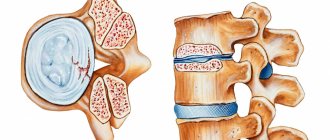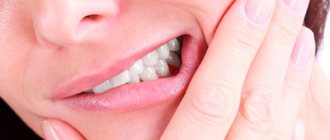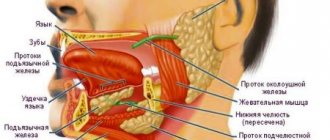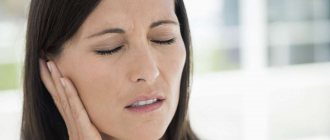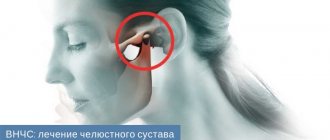Editor and medical expert - Harutyunyan Mariam Harutyunovna
Number of views: 182 270
Last updated: 01/19/2022
Average reading time: 11 minutes
Up to 72% of the working-age population experience neck pain - cervicalgia - at least once a year, and in 1.7-11.5% this problem becomes a cause of disability1.
With age, the number of people experiencing discomfort in the neck area increases; women are more likely to experience this symptom2.
In most cases, cervicalgia is not associated with serious illnesses and, with proper treatment, ends in complete recovery. However, in 10% of cases, neck pain becomes chronic and requires long-term therapy2.
The information presented in this article is strictly for informational purposes only. Keep in mind that if you have a very sore neck, you should under no circumstances engage in self-diagnosis or self-medication. If signs of illness appear, you should consult a doctor.
Up to contents
Varieties
Unpleasant sensations can manifest as neck pain or shooting. Cervicago is an acute syndrome that prevents you from turning your head. Neck aching pain - cervicalgia. It happens:
- Superficial somatic. Occurs when the skin is damaged.
- Deep somatic. Appears when muscles and vertebrae are damaged.
- Visceral. Occurs as a sign of an infectious disease or pathology of internal organs.
If neck pain affects neighboring areas, either cervicobrachialgia (cervicobrachial syndrome) or cervicocranialgia (unpleasant sensations spread to the back of the head and then to the entire head) is diagnosed.
Application therapy Lyapko
Lyapko applicators in various modifications (plates, rollers, application belts, application tapes) are an original, powerful device with many health-improving therapeutic capabilities.
Their action is based on the principles of traditional Chinese medicine - superficial multi-needle acupuncture, as well as on the general physiological mechanisms of life.
Mechanisms of action of the applicator.
The high healing effect of Lyapko applicators is due to a combination of intense reactions:
- reflex-mechanical;
- galvano-electric;
- immunological.
Application therapy has a pronounced analgesic and antispasmodic effect. Improves blood circulation, lymph flow, microcirculation, reduces tissue swelling. Activates tissue mechanisms of immune defense, increases the level of its own opiate peptides and anti-stress hormones in the blood, reduces the level of sensitivity of pain receptors, has a positive psycho-emotional effect and, as a result, stimulates general human adaptation mechanisms. In contact with the skin, the applicator needles stimulate the release of a person’s internal medicines, engaging his “inner doctor” in the work.
It is important to note that local (local) improvement of blood circulation during application therapy occurs without additional stress on the heart, since the work of peripheral circulation increases and the heart rests at this time. This is very important for all categories of patients and, especially, with coronary heart disease, circulatory failure of 1-2 degrees, and elderly people.
For neck pain, many patients experience positive dynamics from Lyapko application therapy. It is combined with all types of medication and physiotherapeutic treatment. The ease of use of Lyapko application devices and their safety make it possible to carry out such procedures at home.
After removing the applicator at the site of its application, all pores are open for 10 minutes, so to improve the healing effect, you can apply ointments and creams that have an analgesic and anti-inflammatory effect.
Causes
Most often, discomfort occurs due to muscle spasms or muscle strain. They happen for the following reasons:
- hypothermia;
- sudden turn of the head;
- staying in the same position for a long time;
- muscle overstrain during work.
The discomfort caused by these factors does not require complex treatment. As a rule, they go away on their own within 1-3 weeks.
If there is severe discomfort, numbness, the patient suffers from dizziness, impaired mobility, the causes of the illness may be much more serious. It is imperative to consult a specialist.
Acute pain syndrome is observed when:
- problems with the spinal column: bruises, soft tissue injuries;
- inflammatory and infectious diseases;
- radiculitis;
- herniated intervertebral discs;
- curvature of the spine in the cervical region;
- osteochondrosis, arthrosis;
- neurological diseases;
- fibromyalgia;
- oncology.
Depending on the disease and its degree, the pain syndrome may vary. Pathology can be suspected based on a number of accompanying signs.
How are lymph nodes treated?
The treatment tactics chosen by the doctor directly depend on the characteristics of the clinical symptoms and the diagnosis. If it's all about a bacterial infection, you can't do without antibiotics. For viruses, antiviral drugs and immunostimulants are indicated. In the case of an autoimmune disorder, the focus is on reducing the activity of specific culprit markers. If cancer is confirmed, chemotherapy, surgery, and immunomodulators are necessary.
If the lymph nodes are enlarged due to a certain dental disease, its step-by-step treatment is carried out. Almost immediately after this, the problem of increased lymphocyte production disappears by itself.
It is extremely important that the patient does not warm the lymph node or apply any compresses unless the doctor has prescribed it. Such actions can aggravate the situation and lead to the development of health-threatening complications.
Pain in the front of the neck
Unpleasant sensations under the chin or along the entire front of the neck may indicate a number of pathologies. The list is impressive:
- inflammation of the lymph nodes;
- angina pectoris;
- cysts and abscesses;
- inflammation of muscles, ligaments and nerves;
- pathology of the thyroid gland.
It is impossible to independently determine which disease this symptom has. The cause of pain can also be pinching of blood vessels or nerves by an intervertebral disc that has become deformed.
Our Innovative Medical Center has developed a set of programs aimed at eliminating diseases without surgery or pills. The team consists of experienced doctors: neurologists, osteopaths, chiropractors, kinesiotherapists, massage therapists.
Pain under the jaw: what causes unpleasant symptoms and how to eliminate them
If you have pain under your jaw, you should not ignore the unpleasant symptoms. They can talk about a number of diseases, some of which pose a serious danger to the body. Pain can also be caused by mechanical stress. When a blow occurs, you should ensure the integrity of the jaw. In any case, you need to visit a doctor. You may need to consult a dentist, surgeon, neurologist, otolaryngologist, or others. To understand which doctor is needed, it is worth analyzing the nature and location of the pain.
Back neck pain
Changes in the spine are the main cause of aching, sharp or nagging pain in the neck area. They occur due to low physical activity and constant work at the computer. Discomfort can be a symptom of the following diseases:
- osteochondrosis - changes in the structure of intervertebral discs;
- protrusion of intervertebral discs (their protrusion);
- intervertebral hernia;
- spondylosis - bone growths on the vertebrae;
- muscle spasms;
- vertebral fractures as a result of whiplash injuries or osteoporosis.
Pain in the back of the neck is a non-standard symptom of spinal tuberculosis, osteomyelitis, and Reiter's syndrome.
First actions
What to do if there is pain in the head and neck? Before you see your doctor, you can try the following:
- Open the windows and ventilate the rooms. The fact is that lack of oxygen also often causes headaches.
- Go for a massage. The main thing is to pay attention to the neck, back of the head and shoulders.
- Lie on your back. The surface must be hard. You need to “stretch” and relax.
- Any bad thought must be driven away. This will help you relax faster.
Pain syndrome in the lateral surfaces of the neck
Discomfort in these areas manifests itself as a burning, throbbing pain, sometimes accompanied by tingling. Unpleasant sensations spread to the shoulder or ear on the right or left. Sometimes they are accompanied by the appearance of secondary torticollis due to the constant tilt of the head to the affected side.
This symptom is inherent in the following pathologies:
- problems with blood vessels, atherosclerosis;
- muscle spasm due to a sharp turn of the head, hypothermia or physical exertion;
- malignant tumors localized in the larynx, thyroid gland, pharynx.
At the initial stage of rheumatoid arthritis, pain can spread to the cervical region, back of the head, and head. When turning the head or bending the neck, it intensifies.
Symptoms
If unpleasant sensations rarely bother you, they may be the result of an uncomfortable sleeping position or awkward head movement. No special treatment is required. To eliminate discomfort, do exercises, light rubbing, take warm baths, it is recommended to use an orthopedic mattress and pillows. But there are situations when you urgently need a consultation with a neurologist or chiropractor.
Warning signs include:
- stiffness of movements;
- the duration of painful sensations is more than 1-2 days;
- the appearance of concomitant pain in the shoulder, arm;
- frequent headaches, especially in the back of the head, which are accompanied by dizziness;
- numbness of fingers, hands.
If you have suffered a neck, head or spine injury and are constantly experiencing pain in these areas, we invite you to contact our Innovative Medical Center for help.
Neck pain: back, front, back of the head, neck, right or left side
One of the most common problems of our time for “office plankton” (and not only) is neck pain caused by muscle strain.
Having sat at the computer all day, buried in gadgets on the way home and spent the evening on social networks, we often experience unpleasant sensations mainly in the back of the neck, shoulders, and back of the head. It is worth noting that pain from muscle overstrain is far from the main problem; what is much more dangerous is that constant overstrain of the neck muscles leads to a feeling of fatigue, disruption of the supply of nutrients and oxygen to the brain, salt deposits, pinched nerves, decreased vision, deterioration of blood supply to the muscles in in general, the appearance of headaches. It would seem that your neck is just tired, but in fact - you are turning into a broken and inoperable object! The most noticeable consequence of such conditions for the person himself is the premature appearance of wrinkles and swelling of the face. The fair half of humanity (and now often men as well) begins to spend a fortune on fighting the signs of aging in cosmetic stores and beauty salons, and without eliminating the main cause, they run cyclically in a circle.
Let's understand what are the main reasons why muscles become overstrained, what we can easily do to relax them and how to avoid the problem from recurring?
The experience of our clinic specialists suggests that in most cases, patients complaining of pain and burning in the neck, shoulders, arms, the area between the shoulder blades and in the back of the head, talking about a feeling of heaviness when “the arms hang like a troglodyte” and “like as if a carload of sacks of flour was unloaded” - they have an overload of the trapezius muscle, located from the base of the skull and ending at the medial edge of the scapula.
Why does my neck hurt? The main causes of neck muscle strain:
- incorrect body position when walking;
- prolonged sitting;
- incorrect body position when working with office equipment;
- habit of constantly looking at a smartphone or other device;
- incorrect posture;
- uncomfortable pillow;
- constant stress;
- inability to properly relax muscles.
If you constantly experience pain in the areas described above, the best solution would be to consult an osteopath to accurately determine the source of the problem! It is not difficult to determine that the problem lies specifically in the trapezius muscle: just “walk” your fingers with light pressure along this muscle and identify trigger points. When you hit a trigger point, the pain begins to spread throughout the muscle. Trigger points can be located at the base of the skull, directly on the neck, at the junction of the muscle from the neck to the shoulder, near the shoulder blades.
Effective ways to help you relieve neck muscle tension:
- Complete relaxation. Even if you do not have the skills and knowledge of relaxation techniques and techniques, a 20-30 minute stay in a quiet room, lying with your eyes closed, when, following slow and deep breathing, you will gradually relax every muscle, starting from the head. We do not encourage you to “learn Zen”, we recommend not to forget about relaxation!
- Massage. If you do not have the opportunity to attract a professional massage therapist to help you, do not ignore the “help yourself” principle. By independently warming up (at first stroking, then massaging in a circular motion) the neck muscles, then kneading the muscles (tapping with the pads of your fingers and pinching) you can achieve noticeable and significant effect. Self-massage is recommended for 5 minutes, ending with stroking along the muscle. Attention: be careful with massages from unqualified specialists and nuggets “from the Tumbu-Yumbu Islands”, unfortunately, we often have to save patients from the consequences of exclusive massage techniques...
- Simple exercises. To relieve stress from the neck muscles, we recommend the following complex: Slowly raise your shoulders as hard as you can up to your ears, fixate on a count of 1-5 and slowly lower them (3-5 times);
- Sit up straight, straighten your back, looking straight ahead, slowly turn your head with your chin to one shoulder, fixing at the end point for a count of 1-10, then turn in the other direction (1-3 times).
- Slowly tilt your head with your ear to the right and left shoulder, holding at the end point for a count of 1-10 (1-3 times);
- Raise your right arm up, bend it at the elbow, grab your right elbow with your left hand and gently pull it towards your head; at the end point, hold for a count of 1-5, repeat with the other hand;
- Squeeze your shoulder blades towards each other (10 times), then move your shoulder blades back (10 times).
- Proper organization of the workplace (monitor at eye level, chair height so that elbows do not hang off the table);
How to relieve neck pain with osteochondrosis
For acute pain, you need to take a non-steroidal anti-inflammatory drug or use a gel or cream with an anti-inflammatory effect. You need to rub the product wherever you feel pain and numbness. If the pain intensifies when you turn your head, you should limit your movements. Do not make sudden head movements. If you have shoulder pain, do not put any weight on your arm. It is possible to use painkillers with a warming effect.
All these recommendations will help relieve pain for 1-2 days. But to prevent repeated attacks, a complete cure for osteochondrosis is necessary. Our clinic specializes in the treatment of diseases of the spine; we employ real masters of their craft. We offer both the most modern and long-proven treatment methods: Hiwamat and UVT therapy, kinesitherapy, therapeutic massage, acupuncture, osteopathy, manual therapy, taping.
Lymphatic changes as one of the causes of pain under the jaw
When discomfort occurs, it is first necessary to assess the health of the submandibular lymph nodes. It is worth excluding or confirming (if pathology is present) lymphadenitis - inflammation that develops when an infection enters the lymph nodes. The disease in its acute form is accompanied by severe pain, body temperature rises, and weakness appears. Discomfort is especially acute when pressing on a sore spot. If timely treatment is not carried out, the disease enters the chronic stage. With different forms of lymphadenitis, an abscess or phlegmon can develop - a purulent formation.
Lymph nodes can become inflamed, for example, in acute and chronic tonsillitis. In this case, it can hurt from different sides under the jaw. But other symptoms come to the fore: acute pain in the throat (especially when swallowing), purulent plaque on the tonsils, fever - even up to 40˚C.
If the lymph node in the neck hurts, this may also indicate the appearance of a neoplasm. More often these are metastases that penetrate from other organs. The nature of the pain varies. The patient has an elevated body temperature for a long time, weakness appears, and he sharply loses weight.
Diagnostics
A neurologist is primarily involved in the treatment of neck pain. At the reception, the specialist listens to the patient’s complaints and conducts an examination. It determines the cause of the problem. Most often it becomes a deviation from the norm in the condition of the spine. These changes are the cause of the development of concomitant diseases of internal organs.
Each segment of the spinal cord is responsible for the functioning of a specific organ. When the vertebrae change position or the height of the intervertebral discs decreases, the transmission of nerve impulses from the spinal cord to the internal organs is disrupted.
If the problem is in the cervical region, the ENT organs, vocal cords, thyroid and parathyroid glands, neck muscles or forearms are affected. Those. Problems with the spine and diseases of internal organs are more often diagnosed. Therefore, for aching neck pain, examination by a chiropractor is recommended. If other diseases are detected, additional examination by specialized specialists: cardiologist, endocrinologist, otolaryngologist.
In our Innovative Medical Center, a patient complaining of discomfort in the cervical spine undergoes a comprehensive diagnosis. The list of procedures includes:
- blood test: general and biochemical;
- blood test for thyroid hormone levels;
- computed tomography of the cervical spine;
- magnetic resonance imaging of the neck area;
- Ultrasound examination of the vessels of the neck, salivary glands, thyroid gland with Doppler ultrasound.
Using MRI, a specialist examines in detail the condition of the intervertebral discs. The method allows you to diagnose diseases in the early stages. The doctor will assess the condition of the blood flow. If there is compression of the spinal cord and its roots, he will see them in the image.
Contact us
Call now
8 (495) 803-27-45
Make an appointment through our service
Make an appointment
Professional medical care
Our clinic understands that each patient is individual and prescribes therapy only if the entire clinical picture of his condition is available. After consultation, examination, collection of information about a person’s lifestyle, previous diseases and hereditary predisposition, diagnostic studies, the patient is selected a course of treatment aimed at quickly relieving pain, reducing the manifestation of symptoms of pathology and restoring the functionality of systems.
Our clinic has a convenient appointment schedule for specialists and a diagnostic center, a pleasant atmosphere and responsive staff. All doctors have extensive practical experience and prescribe the optimally effective course of therapy, individual for each specific case. All patients are closely monitored by the best neurologists, physiotherapists, and vertebrologists, who monitor the treatment process and adjust it if necessary. They don’t waste money on useless ointments, patches, and don’t take unnecessary painkillers. The advanced treatment methods we use help alleviate the condition already at the first visit, and then cope with the problem in just a couple of appointments. With us you will again feel lightness and freedom of movement.
Published medical histories are not the basis for making a diagnosis and prescribing therapy on your own. Self-medication can lead to disability. The presence of one or more of the above symptoms is a reason to seek help from a doctor.
Treatment of cervical pathology
After diagnosis, the doctor develops an individual treatment strategy for each patient. It takes into account the severity of changes in the affected area, concomitant diseases, age and level of physical development. A set of measures is being carried out aimed at eliminating the symptoms and causes of the pathology.
Physiotherapy
The Innovative Medical Center conducts sessions using modern Hivamat 200 Evident devices and equipment for shock wave therapy. With the help of these procedures, swelling and inflammation are relieved, and blood flow in the damaged area is improved. After a course of UVT therapy, the elasticity of ligaments and tendons is restored, and metabolism is accelerated.
Taping
This method of manual therapy relieves pain and restores damaged muscles. Special thermally coated bandages are used. They are carefully fixed on the damaged part of the body.
Manual therapy
For pathologies of the cervical spine, it is performed using several techniques. The session begins with a relaxing massage with increasing tempo of kneading. The effect is felt after 1 procedure. After the course, the vertebrae return to their anatomically correct position, and muscle spasms are eliminated. Blood circulation improves, soft tissues are restored.
Acupuncture
The procedure is indicated for various diseases of the musculoskeletal system. The effect on biologically active points of the body allows you to eliminate neck pain and weakness, and increase blood supply in this area.
Massotherapy
An auxiliary method of therapy is effective for osteochondrosis and other diseases of the spine. After the procedures, discomfort, swelling, cramps, and fatigue are eliminated. Improves blood flow, the patient’s well-being and emotional state. Either local or general massage is prescribed. Techniques are selected individually for each specific case.
Kinesitherapy
Exercise therapy and classes on special decompression simulators are prescribed to strengthen the muscle corset. During the procedures, the load is removed from the spine and the risk of cartilage abrasion is minimized. A large hall with additional equipment is equipped for classes - rollers, balls. Doctors and experienced instructors supervise the exercises.
Prevention
To maintain good health after treatment, the patient should take the following preventive measures.
Prevention helps avoid relapse
- Exercise. Running, walking, swimming are just a couple of examples of sports disciplines that can help improve well-being and maintain proper function of the neck muscles.
- Physical exercise. Exercising in the morning, warming up before, during or after work - all this is also extremely beneficial for the neck and head.
- Maintaining correct posture. With correct posture, the work of the brain and neck muscles proceeds normally, and the person feels good.
- Change your diet. Add fatty fish, vegetables, fruits and dairy products. Remove smoked, salty and spicy foods, as well as chocolate, nuts and coffee.
- To refuse from bad habits. Smoking and alcohol have a destructive effect on the body. Getting rid of them significantly improves your health.
These measures, when carried out carefully, help maintain the good condition of the body.
